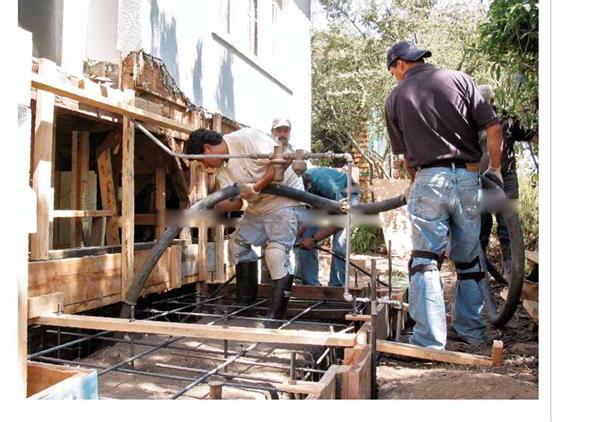ATTACHING THE MUDSILL
Builders may attach new mudsills at different stages of form assembly. But here are the essentials. Before nailing up the mudsill (to the bottom of the pony-wall studs) predrill for anchor bolts, as described earlier, making sure that no bolt occurs under a stud. If local codes require metal termite shields, tack them to the underside of the mudsill after first predrilling it with anchor-bolt holes. Then, using a pneumatic nailer, end-nail the sill to the studs, using two 16d nails per stud. If there isn’t enough room to end-nail upward into the sill, jack the mudsill tight to the studs and toenail down from the studs into the mudsill.
Once the mudsill is nailed to the studs, insert anchor bolts into the predrilled holes, screw on washers and nuts, and tie the free ends of the bolts to the rebar. At this point, the nuts should be just snug; you can tighten them down after the concrete has cured. If you end – nailed the mudsill, make sure the studs are tight to the top plates above: Jack up any studs that have separated. You may also need to brace the pony wall if it’s loose, which is often the case if you have to demolish siding to remove it. Pony walls should be plumb and aligned with the forms.
After installing the outside form boards, you are almost ready to pour. If you are using a 2-in. hose (interior diameter) to pump the concrete to the site, make sure there is at least a 3-in. clearance between the edge of the form board and the outside edge of the new mudsill, to accommodate the width of the pump nozzle. If necessary, notch the forms so the nozzle can fit. The top of the form should be slightly higher than the bottom of the mudsill.
Fill the footing to the bottom of the wall forms before filling the forms. Some concrete may slop over from the walls onto the footing and bottom form boards, but slopover isn’t a problem if you remove the concrete from the form bottoms before it sets up. That will allow easy removal of the forms once the concrete has cured.
When the concrete begins to set, but is not completely hard, pull out the perforated steel stakes holding the bottom form boards in place. To do this, remove the duplex nails and then use either a pipe wrench to grip the stakes or a commercial stake puller. If you leave the stakes in till the next day, you’ll likely be able to pull them only if you remembered to oil them first.

 This 2-in. (interior diameter) concrete-pump hose is easier to handle than a 3-in. hose. But its smaller diameter requires smaller, 7o-in. aggregate in the mix. Although a 2-in. hose is much lighter than a 3-in., tons of concrete pass through it—so you’ll need helpers to support the hose and move it to the pouring points.
This 2-in. (interior diameter) concrete-pump hose is easier to handle than a 3-in. hose. But its smaller diameter requires smaller, 7o-in. aggregate in the mix. Although a 2-in. hose is much lighter than a 3-in., tons of concrete pass through it—so you’ll need helpers to support the hose and move it to the pouring points.







Leave a reply